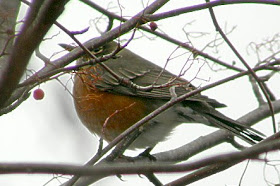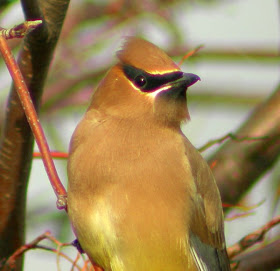 Quicksilver the "Jungle Bird"--D.B.
Quicksilver the "Jungle Bird"--D.B.
Cockatiel Rico courtesy of Bensem51
This is a continuation of the conversation about birds and mirrors that started on the post Sunday Miscellany, posted on November 17th, which evolves to questions about "why" in relation to what we as humans find to be somewhat inexplicable bird behavior.
From Sally--
My cockatiel flew into the mirror in the bathroom often so I have to shut the door to it when she is out. She also has long conversations with the birdy in the mirror when she perches on the kleenex box! Guess she is just dumb...she also talks to remote controls and random hairbrushes, too. She may not be an average bird...
Monday, November 17, 2008 5:09:00 PM EST
Sally, Sorry, one thing I forgot to mention about my second bathroom and its mirror. The bathroom is quite small and the mirror only reflects the opposite wall and curtained window, as opposed to a mirror that reflects a more spacious room which gives a bird the impression that there is a good distance to go before a solid surface is encountered. Do you think it might be possible that your Cockatiel isn't just accidentally running into the mirror but rather going for the bird she's seeing?When I bring in a bird who is going to be staying and will be free flying in the house at times, I do a circuit of the house and show the bird all the windows and mirrors. I put them very close so their beak touches the surface and I also knock on the glass. For the most part the pigeons and Quicksilver the African Grey "got it". Pinkie, our rescued Laughing Dove runs into everything as he has absolutely no control of his flight. I understand that is a feature of this human bred breed. He now realizes that flying just isn't for him so he trots around on the floor (attempting to pick fights with birds three times his size) while the cages are being cleaned. (We're very careful not to step on him.)
Silver seems to understand that that his reflection is not another bird. Pinkie tries to start fisticuffs with his reflection. One of the female pigeons Thumper,is completely enamored with her reflection. Most of the others aren't particularly interested one way or the other. Except Sesame, a little brown dove, who upon having access to a mirror began to lay eggs one right after another until we put the mirror where she couldn't see it.
Now, now, let's not jump to conclusions about your cockatiel. I've seen any number of birds who interact with their reflections. But I'd love to know why the remote controls and the hairbrushes. There has to be something that is cueing her to talk, wouldn't you think? Now Silver sometimes looks like he's talking to empty boxes are sticking his head into cans or cups and talking to them. But in those cases he's listening to how talking in those confined spaces changes the sound.
Could it be something about the pattern of "spots" or whatnot on remotes and hairbrushes that is cuing your cockatiel to talk? Silver does say "hairbrush". He finds it gets a laugh if he says it from deep in the recesses of his carrier while we ride in crowded elevators. As to remotes none of ours any longer have their red power buttons. Silver goes on a mission to remove them as soon as possible whenever a new remote appears in the house.
Monday, November 17, 2008 9:38:00 PM EST
Sally said...
Tuft the cockatiel has always been enamoured with things that have buttons, like remotes and telephones, and the plastic-round-tipped bristle hair brush. I don't know how she reacts to regular bristle hair hair brushes. She postures, and stands up so straight and talks her limited "hello" "pretty girl" "kiss-kiss-kiss" vocabulary and sometimes really starts in chattering things I don't understand but she is definitely having a conversation. She responds similarly to the cat as well when she comes to sniff her, not a wise behavior at all. She even does it to my border collie! SO-shiny things, things with buttons and bristles, and furry things. Hmm.
She has done it since she was quite young, probably from when we got her 15 years ago as 'weanling" however old young cockatiels are released from breeders as she was locally bred for a small mom-pop pet shop here. We quickly learned we couldn't have a mirror in her cage as she got VERY defensive of it and was quite mean with a mirror around, I guess she was defending her "friend". She is usually very social unless she is near a mirror, or sometimes defends shiny things she is playing with, like my watch, when you try to remove her from it or it from her. I am sure she is no where near as clever as Silver!
Monday, November 17, 2008 10:00:00 PM EST
Quicksilver defends loose change. I don't think it has anything to do with the shine in his case but more to do with his opinion that our picking up the coins was an intrusion. We used to dump the contents of piggy banks in the middle of the bed and Silver would stand on the coins and dig with his feet. Head down, legs swinging backwards while coins went zooming around the room. He enjoyed it immensely. Then one day when we went to put the coins away he puffed up his feathers, hunched forward, ran at our hands, with his beak at the ready to keep us from putting the coins away.
It turns out that this digging response is innate in African Greys and it's thought that the impulse comes to dig as the way to rid the nesting cavity of debris. Silver also digs when the bed covers are tented over him. When he did the coins he wasn't under the covers but perhaps the previous experience of a cavity like space on the bed, along with the coins somehow equaling debris triggered his protective response.
When it comes down to it, we know so little about the innate behavioral wiring of these tame members of wild species that some behavior seems completely inexplicable or put down to other stimuli until we learn the "button" that we've accidentally pushed.
If anyone has any ideas about why Tuft does what Tuft does in speaking to hairbrushes and remotes, please chime in. D.B.






















































